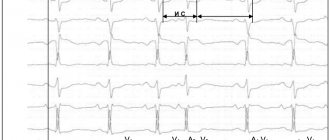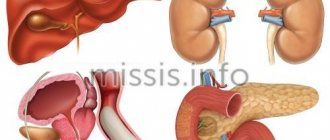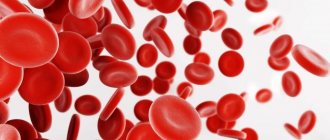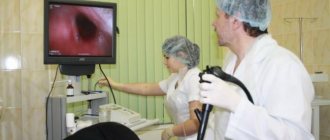V.V. Osovskikh1, M.S. Vasilyeva2, A.E. Bautin2, L.N. Kiseleva1
1 Federal State Budgetary Institution Russian Scientific Center of Radiology and Surgical Technologies named after. A.M. Granova, St. Petersburg, Russia
2 Federal State Budgetary Institution National Medical Research Center named after. V.A. Almazova, St. Petersburg, Russia
For correspondence: Viktor Vasilievich Osovskikh – Ph.D. honey. Sciences, doctor of the department of anesthesia and resuscitation of the clinic of the Russian Research Center for Chemistry and Chemistry of Chemistry named after. A.M. Granova, St. Petersburg, Russia; e-mail: [email protected]
For citation: V.V. Osovskikh, M.S. Vasilyeva, A.E. Bautin, L.N. Kiseleva. Prognostic value of individual markers of hypercoagulation in sepsis. Bulletin of Intensive Care named after. A.I. Saltanova. 2020;3:66–73. DOI: 10.21320/1818-474X-2020-3-66-73
Essay
Relevance. Sepsis is a heterogeneous syndrome caused by an imbalanced host response to infection, leading to organ dysfunction. The coagulopathy that develops has varying degrees of severity, and the incidence of overt disseminated intravascular coagulation (DIC), depending on the diagnostic criteria, varies from 30 to 60%. Although diagnosing overt disseminated intravascular coagulation is not difficult, identifying the hypercoagulable stage that precedes it is problematic because it is not detected by available coagulation screening tests. The lack of early diagnosis hinders the development of preventive therapy for DIC.
Purpose of the study. To evaluate the frequency of detection of individual hypercoagulable markers in septic patients with a hypercoagulable thromboelastometry (TEM) pattern and their relationship with disease outcome.
Materials and methods. Screening patients with sepsis using TEM identified 85 hypercoagulable patients. A thrombin generation test with the addition of thrombomodulin was performed from plasma samples, screening indices of coagulation, levels of physiological anticoagulants, and selected markers of hypercoagulability were determined. Subsequently, the groups of survivors and those who died were identified.
Results. The group of survivors included 62 patients, those who died - 19. In the thrombin generation test, hypercoagulation was detected only in 7 cases. The groups of survivors and those who died did not differ significantly in the degree of decrease in endogenous thrombin potential: 20 (10–25)% and 14 (10–31)%, respectively, and peak thrombin concentration: 8 (2.9–16)% and 7 (3– 18)% respectively. The groups of survivors and those who died were significantly different: protein C 79.5 ± 28% and 64.9 ± 25%, factor VIII 226.4 ± 66% and 276.6 ± 94%, von Willebrand factor 269 ± 129% and 435 ± 181 %, antithrombin 82 (60–94) % and 65 (41–80) % and D-dimer 2157 (1341–3964) μg/L and 3253 (1911–6914) μg/L, respectively.
Conclusion. Patients with sepsis who have signs of hypercoagulation according to TEM criteria have different combinations of thrombophilia markers. Local screening coagulation tests do not affect prognosis. Low levels of protein C and antithrombin, as well as high levels of factor VIII, von Willebrand factor, and D-dimer, have a moderate prognostic value and can potentially influence therapy.
Key words: sepsis, thrombophilia, thromboelastography, thrombin, thrombomodulin, disseminated intravascular coagulation
Received: 15.03.2020
Accepted for publication: 02.09.2020
Read article in PDF
Statistics Plumx Russian
Introduction
Sepsis is a heterogeneous syndrome caused by an imbalanced host response to infection, leading to organ dysfunction [1]. The pathogenesis of coagulopathy developing against the background of sepsis includes several mechanisms.
A decrease in antithrombin levels is detected in half of patients with sepsis, and protein C deficiency is detected in the vast majority. Under physiological conditions, antithrombin inhibits thrombin and other coagulation factors (VII, IX, X and XI), and protein C, activated by the thrombin–thrombomodulin complex on the surface of endothelial cells, inactivates factors Va and VIIIa, breaking positive feedback loops and acting as a natural anticoagulant. A state of increased procoagulant activity and impaired fibrinolysis leads to the formation of fibrin clots in the microvasculature and, as a consequence, organ failure [2, 3]. Coagulopathy has varying degrees of severity, with the incidence of overt disseminated intravascular coagulation (DIC) reaching 30% when assessed according to the International Society on Thrombosis and Haemostasis (ISTH) criteria and about 60% according to the Japanese Association for Acute Medicine (JAAM) criteria. [4]. The question remains controversial whether the severity of DIC is independent of the Acute Physiology and Chronic Health Evaluation (APACHE) II score and Sequential Organ Failure Assessment (SOFA) score a predictor of death, or whether the prognosis is determined by the severity of the general condition. The first statement has dominated the literature since the publication of the PROWESS study in 2004. An alternative opinion was expressed in 2021 based on the results of a large epidemiological study of DIC in Japan, where the authors showed the superior prognostic value of the APACHE and SOFA scales over the existing DIC scales (ISTH and JAAM) [4]. Although diagnosing overt DIC syndrome according to ISTH criteria is based on publicly available markers and is usually not difficult, identifying this (advanced) stage of septic coagulopathy not only does not open up new therapeutic options, but also sharply reduces the effectiveness of existing ones. Experimental studies of endotoxemia confirm the presence of a hypercoagulation phase preceding the development of hypocoagulation [5]. Detection of the earlier (hypercoagulable) stage of DIC in the clinical setting poses a diagnostic challenge because common coagulation screening tests are either insensitive or nonspecific in this regard. This, in turn, hinders the development of targeted preventive therapy at the early stage of DIC.
Currently, it is common to divide methods for diagnosing hemostasis into integral (evaluate the operation of the system as a whole) and local (evaluate individual links or individual factors). In turn, local tests are divided into screening and specialized. The most popular screening tests are prothrombin time and activated partial thromboplastin time. It has been shown that individual coagulation markers (hereinafter we will refer to them as specialized tests) highly correlate with the presence of hypercoagulable shifts in the hemostatic system against the background of sepsis, but their use in clinical practice is not routine. The most frequently mentioned in the context of diagnosing hypercoagulation are D-dimer, protein C, protein S, antithrombin, factor VIII, and von Willebrand factor.
Integrated coagulation tests, such as thromboelastography (TEG), thromboelastometry (TEM), have become widespread as methods for monitoring coagulopathies associated with surgery and trauma. One of the advantages of global tests is their ability to detect hypercoagulability. It is known that TEG and TEM are suitable for identifying hypercoagulability and predicting thrombotic complications in certain groups of patients [6, 7], but their use in conditions of sepsis is controversial [8]. Since TEG/TEM techniques are as close as possible to the patient (the so-called point of care testing), they are obvious candidates for screening the global status of the coagulation system and primary risk stratification. The choice of TEG/TEM criteria for hypercoagulation should be discussed separately. When comparing TEM parameters of healthy volunteers and patients with confirmed thrombotic complications, it was found that the most specific and sensitive markers of thrombotic complications are clot formation time (CFT), maximum clot density (MCF) and thrombodynamic potential according to C. Ruby, which is the quotient of maximum elasticity and clot formation time (TPI = MCE/CFT) [7]. Since maximum clot density is due to the contribution of both fibrin and platelets, a new parameter, “delta,” has been proposed to distinguish between platelet and plasma hypercoagulability. According to the basic algorithm of TEG/TEM operation, the initial period of time r (in TEG devices) or the so-called thrombus formation time (CT) (in TEM devices) ends when the “branches” of TEG/TEM diverge by 2 mm. However, it is at the end of this time interval that active generation of thrombin begins. By displaying the first derivative of the change in clot density (i.e., velocity), it is possible to see the beginning of this process and thus calculate the delta time from the beginning of the first derivative curve to the end of the interval r (or CT). The combination of a high maximum clot density with a short “delta” (less than 0.6 min) is associated with plasmatic hypercoagulation, and the combination with a longer “delta” is associated with platelet hypercoagulation [9]. The connection between normo-, hyper- and hypocoagulation patterns of TEG/TEM and the course of sepsis was traced in a study by S. Ostrowski et al. [5]. The maximum TEG amplitude (corresponding to the maximum clot density in TEM tests) was chosen as the basic criterion. It was shown, in particular, that at the time of diagnosis of sepsis, 22% of patients had a hypocoagulable and 30% had a hypercoagulable TEG pattern. In most patients, the initial TEG characteristics were maintained throughout four days of observation. The development of hypocoagulation on any day of the study was an independent risk factor for death. Identification of a hypercoagulation pattern against the background of sepsis had no prognostic significance; the mortality rate of patients in this group did not differ significantly from the normocoagulation group. The association of hypocoagulation disorders TEG/TEM, which developed against the background of sepsis, with an unfavorable outcome was confirmed in a number of other studies [8], which is consistent with the presence of obvious DIC syndrome in this group of patients. The thrombin generation test is also an integral hemostasis test. The most widely used method is fluorescent detection and automated calculation of the amount of thrombin, proposed by C. Hemker. The acceptable platelet content in plasma depends on the purpose of the study. From a practical point of view, the use of platelet-poor plasma is preferable, as it allows samples to be frozen and stored, and also simplifies the procedure for interlaboratory control. Data from studies using the original method of C. Hemker, performed in the early stages of sepsis development, are contradictory. A number of observations did not demonstrate an increase in thrombin generation, which could explain the hypercoagulable status of patients [10]. On the contrary, in a study by Russian authors, an increase in thrombin generation was noted in patients with abdominal sepsis [11]. In this regard, it is of interest to modify the thrombin generation test with the addition of recombinant human thrombomodulin (protein C activator), which allows, to some extent, to simulate in vivo coagulation conditions. The dose of thrombomodulin is selected to reduce the area under the thrombin concentration curve (the so-called endogenous thrombin potential, ETP) by 50% and the peak thrombin concentration (Peak) in the plasma of healthy donors by 40%. An insufficient decrease in Peak and ETP indicates abnormalities in the protein C system. The question of the combination of the hypercoagulable status of patients with sepsis (based on TEG/TEM screening) and other markers of hypercoagulability, as well as the prognostic value of such combinations, is the object of our study.
The purpose of the study was to evaluate the frequency of detection of individual hypercoagulable markers in septic patients with a hypercoagulable TEG/TEM pattern and their relationship with disease outcome.
Hypercoagulation - causes, symptoms, treatment
Symptoms of hypercoagulosis are most often painful conditions caused by a disorder in the form of excess platelets or factors that should suppress the coagulation system. Causes of thrombophilia: anemia, dehydration, prolonged immobilization. Blood tests - PT and APTT are crucial in diagnosing the disease. Hypercoagulability is treated with blood thinning medications.
Fotolia
Materials and methods
Eighty-five patients (58 men and 27 women) admitted to the surgical intensive care unit with a diagnosis of sepsis were examined prospectively and retrospectively. Median age 60 (50–66) years. 70 out of 85 patients had abdominal localization of the primary septic focus (peritonitis, pancreatitis, cholangitis, etc.). In some cases, the reliable localization of the primary septic focus remained uncertain (for example, when infiltrates of lung tissue were detected simultaneously with purulent cholangitis). In all cases, the diagnosis of sepsis was made based on current recommendations from the Surviving Sepsis Campaign and the Sepsis-3 Consensus Conference. In most cases (more than 70%), systemic infections were caused by gram-negative bacilli, less often by gram-positive cocci. Verification of the pathogen was not always possible (for example, with pancreatitis). We used a combination of procalcitonin levels (threshold value above 2 μg/L) and C-reactive protein (threshold value above 50 mg/L) as surrogate markers confirming the bacterial etiology of the systemic inflammatory response. Treatment of sepsis was carried out in accordance with the recommendations of the Surviving Sepsis Campaign. The routine use of anticoagulants for the prevention of thromboembolic events was complicated by the need for repeated surgical interventions, installation of new drains, etc. Thus, in most cases, anticoagulant therapy in the form of infusion of unfractionated heparin or subcutaneous administration of low molecular weight heparin was inconsistent, “mosaic” in nature. In cases of severe antithrombin deficiency (less than 40%), lyophilized antithrombin preparations or fresh frozen plasma were used. ROTEM tests were performed in all patients upon diagnosis of sepsis, as well as in patients with newly diagnosed C-reactive protein and procalcitonin levels above the threshold values (see above). Determination of coagulation status in terms of screening coagulogram, antithrombin and D-dimer was carried out on a daily basis. The frequency of repetition of TEM tests depended on the clinical situation (more often in case of bleeding). Blood was collected into vacuum tubes with 3.2% sodium citrate (Vacutainer, BD, USA), usually from an arterial or central venous catheter. Thromboelastometry from whole (citrated) blood samples was performed using ROTEM Delta or ROTEM Gamma devices (TEM International, Germany). We used original reagents EXTEM, INTEM, FIBTEM (TEM International, Germany). The following criteria were considered for hypercoagulation: CTextem < 45 s, CTintem < 120 s, MCF > 72 mm, TPI > 3.5, α > 78°. Platelet-poor plasma was obtained from sodium citrate-stabilized blood samples by two-stage centrifugation at 2500 G for 15 min (Eppendorf Centrifuge 5804, Eppendorf, Germany). Next, the samples were aliquoted and frozen at –85°C. Determination of prothrombin index, activated partial thromboplastin time, fibrinogen, von Willebrand factor was performed on the STA Compact device (Diagnostica Stago, Italy) using original reagents. To determine antithrombin, protein C, protein S on the same equipment, the reagents Stachrom ATIII, Stachrom Protein C, Staclot Protein S were used, respectively. The activity of factors V and VIII was measured on an ACL TOP 300 coagulometer (Instrumentation Laboratory, USA) using original reagents. The content of D-dimer and procalcitonin was determined using a VIDAS analyzer (bioMerieux, France). The thrombin generation test was performed in the blood coagulation laboratory of the Federal State Budgetary Institution “Russian Research Institute of Hematology and Transfusiology”. The Calibrated Automated Thrombogram technique (Thrombinoscope BV, the Netherlands) was used using a Fluoroscan Ascent plate fluorimeter (ThermoFisher Scientific, Finland). In parallel, a standard thrombin generation test and a test with the addition of recombinant human thrombomodulin were performed, based on the results of which endogenous thrombin potential (ETP), peak thrombin concentration (Peak) and the degree of reduction in ETP and Peak values (in %) were assessed. The results of ROTEM, screening coagulation, antithrombin and D-dimer tests were available to the intensive care unit staff in real time and could influence decisions about the initiation/withdrawal of anticoagulant therapy. The remaining coagulation tests (protein C, protein S, von Willebrand factor, factor V, factor VIII, thrombin generation test) were performed from frozen samples and information on them was only available retrospectively. To diagnose overt DIC syndrome, the ISTH overt DIC criteria were used (Taylor FB, 2001). The type of distribution of parametric variables was assessed using the Shapiro-Wilcoxon test. Variables are presented as either M ± SD (normal distribution) or Me (Q1–Q3) (non-normal distribution). Depending on the type of data, differences between groups were assessed using the t-test, Mann-Whitney method, and Fisher's exact test. The relationship between individual variables was assessed using the Pearson correlation coefficient. The critical level of significance was considered p < 0.05. Statistical analysis of the data was carried out using the MedСalc program version 19.0.3.
Appendix A1. Methodology for developing clinical guidelines
Target audience of these clinical recommendations:
— Doctors, anesthesiologists and resuscitators.
— Obstetrician-gynecologists.
— Transfusiologists.
results
Based on 28-day survival data, patients were divided into survivors (n = 62) and deaths (n = 23). The groups did not have significant differences in gender and age. The time interval from detection of the fact of hypercoagulation to discharge from the hospital (for survivors) or to death also did not differ. The SOFA score in the group of deceased patients was significantly higher (6 (4–10) points) than in those who survived (4 (3–5) points); the number of patients in a state of distributive shock requiring vasopressor infusion also differed significantly, 8 and 6, respectively (p = 0.01) (Table 1). The most common sign of hypercoagulation according to thromboelastometry results was the maximum clot density in INTEM tests; differences between groups were not significant. The thrombodynamic potential index, which reflects both the density and kinetics of clot formation, also did not differ significantly in the groups of survivors and those who died: TPI 5.9 (5.1–7.4) and 6.7 (4.9–8.3) respectively (p = 0.5). Thrombin generation tests suitable for evaluation were performed in 59 patients, of which 43 survived and 16 died. When performing this test, hypercoagulation (increased endogenous thrombin potential and peak thrombin concentration) in the native thrombin generation test was observed in only seven cases. In the remaining samples, thrombin generation was within normal values or reduced. Peak values of thrombin generation were significantly different: 210 ± 91 nmol/L in survivors, 148 ± 86 nmol/L in deceased, p = 0.02. When performing tests with the addition of recombinant human thrombomodulin, in 41 cases (68%) low sensitivity to thrombomodulin was observed, manifested by insufficient suppression of ETP and Peak. The groups of survivors and those who died did not differ significantly in the degree of reduction in ETP: 20 (10–25)% and 14 (10–31)%, respectively, and Peak: 8 (2.9–16)% and 7 (3–18)%, respectively (Table 2). The results of a modified thrombin generation test with thrombomodulin indicate a deficiency in the protein C system, which is confirmed by a lower level of protein C in the group of deceased compared to survivors (64.9 ± 25% and 79.5 ± 28%, respectively, p = 0.04 ). Fibrinogen concentration, prothrombin index and activated partial thromboplastin time were assessed as standard (screening) coagulogram indicators (Table 1). There was no significant correlation between individual parameters of integral tests and screening coagulogram parameters.
Table 1. General characteristics of patients depending on outcome
Table 1. Demographics and clinical characteristics of patients depending on outcome
| Index | Survivors | Dead | p |
| Age, years | 59 (50–66) | 64 (56–69) | 0,2 |
| Procalcitonin on the day of the study, mcg/l | 1,9 (0,3–5) | 3,2 (1,2–6,5) | 0,1 |
| C-reactive protein, mg/l | 120 (71–223) | 197 (126–289) | 0,03 |
| Bilirubin µmol/l | 16 (9–30) | 42 (17–129) | 0,001 |
| Creatinine µmol/l | 72 (60–108) | 130 (73–214) | 0,006 |
| Leukocytes, 109/l | 12 (9–16) | 14 (11–17) | 0,09 |
| Platelets, 109/l | 289 (204–406) | 226 (211–334) | 0,09 |
| Fibrinogen, g/l | 5,5 ± 1,8 | 6,0 ± 2,4 | 0,3 |
| Prothrombin index according to Quick, % | 66 ± 18 | 61 ± 19 | 0,3 |
| Activated partial thromboplastin time, s | 41,9 (35–52) | 47,1 (38–56) | 0,2 |
| Factor V, % | 104 (89–130) | 102 (82–132) | 0,9 |
| Factor VIII, % | 226,4 ± 66 | 276,6 ± 94 | 0,03 |
| Von Willebrand factor, % | 269 ± 129 | 435 ± 181 | 0,02 |
| D-dimer, µg/l | 2157 (1341–3964) | 3253 (1911–6914) | 0,009 |
| ISTH DIC score, points | 3,5 ± 1,2 | 4,0 ± 1,1 | 0,09 |
| SOFA score, points | 4 (3–5) | 6 (4–10) | <� 0,0001 |
| Bed days (until discharge or death) | 20 (12–30) | 20 (9–35) | 0,897 |
The activity of protein C, factor VIII, von Willebrand factor, antithrombin and D-dimer content were significantly different in the groups of survivors and those who died. For protein S and factor V, the differences were not significant (Table 2, Fig. 1). The short-lived vitamin K-independent factor V in this case characterizes the normal synthetic function of the liver in both groups. Interestingly, the levels of specific hypercoagulation markers correlated very weakly with each other, i.e., each patient had his own individual “fingerprint” of the markers. The exception is the correlation between antithrombin activity and protein C (r = 0.459, p < 0.0001).
Table 2. Data from integral coagulation tests and levels of physiological anticoagulants
Table 2. Viscoelastic tests results and anticoagulants levels
| Index | Survivors | Dead | p |
| Time of thrombus formation CTextem, s | 76,5 (64–90) | 86,5 (68–129) | 0,1 |
| Time of thrombus formation CTintem, s | 191 (167–216) | 184 (155–221) | 0,3 |
| Angle alpha ROTEM, degrees | 80,2 ± 2,1 | 80,1 ± 2,3 | 0,9 |
| CFTextem clot formation time, s | 47,5 (42–56) | 50,5 (42–59) | 0,5 |
| Clot formation time CFTintem, s | 50 (40–58) | 48 (40–54) | 0,5 |
| Maximum clot density MCFintem, mm | 74 (73–78) | 74 (73–78) | 0,6 |
| TPI | 5,9 (5,1–7,4) | 6,7 (4,9–8,3) | 0,5 |
| ETP, nmol min | 1489 ± 592 | 1139 ± 573 | 0,4 |
| Peak, nmol/l | 210 ± 91 | 148 ± 86 | 0,02 |
| ETP with thrombomodulin, nmol min | 1199 ± 530 | 926 ± 445 | 0,07 |
| Peak with thrombomodulin, nmol/l | 194 ± 91 | 135 ± 73 | 0,02 |
| Decrease in ETP in the test with thrombomodulin, % | 20 (10–25) | 14 (10–31) | 0,7 |
| Reduction in Peak in the test with thrombomodulin, % | 8 (2,9–16) | 7 (3–18) | 0,8 |
| Antithrombin, % | 82 (60–94) | 65 (41–80) | 0,003 |
| Protein C, % | 79,5 ± 28 | 64,9 ± 25 | 0,04 |
| Protein S, % | 69,4 ± 29,4 | 60,1 ± 25,7 | 0,17 |
Rice. 1. Levels of specific markers of hypercoagulation in the group of survivors (white rectangles) and deceased patients
Fig. 1. Levels of specific markers of hypercoagulability in survivors (white boxes) and nonsurvivors
As follows from the analysis of ROC (receiver operating characteristic) curves (Fig. 2), all the studied markers in combination with the hypercoagulable TEM pattern have a relatively low predictive ability. The highest area under the curve was found in the von Willebrand factor (0.789; p = 0.012). For comparison: SOFA score (area under the curve 0.750, p < 0.001). Due to the small number of observations, the predictive value of the given ROC curves did not differ significantly.
Rice. 2. Examples of ROC curves for the predictive ability of individual hypercoagulability markers
Fig. 2. ROC curves examples of prognostic values of hypercoagulability markers
What are the causes of hypercoagulability?
The coagulation process is an extremely complex phenomenon and requires the participation of several organs to function properly. To form a clot in a damaged blood vessel, such as after an injury, you need platelets produced by specialized bone marrow cells called megakaryocytes, clotting proteins such as fibrinous fibrin, which require active thrombin to form from a precursor.
The liver is responsible for the synthesis of coagulation proteins. Proper functioning of healthy blood vessels (veins and arteries) is also important. Consequently, coagulation disorders with excessive clotting occur as a result of bone marrow diseases (some leukemias produce excessive platelets), liver diseases that result from a deficiency of proteins that interfere with clotting, and damage to blood vessels (for example, as a result of atherosclerosis). Iron deficiency anemia is the most common cause of hypercoagulability (thrombocythemia) among the Polish population. Cardiac arrhythmias (atrial fibrillation) cause clots to form in the blood and in the atria of the heart.
About
Discussion
We found that patients with sepsis who have the same TEM pattern of hypercoagulation, nevertheless, have a different combination of thrombophilia markers, which casts doubt on attempts to replace coagulopathy with any one single-component drug. When planning studies to correct septic coagulopathy, it is necessary to take into account the heterogeneity of this group of patients. As critics point out, the failure of clinical trials of various anticoagulants in sepsis stems from a failure to identify patients who are more likely to respond positively to the test drug. Examples include studies of activated protein C (except PROWESS), antithrombin, tissue factor pathway inhibitor. The history of the thrombomodulin study (SCARLET), which ended negatively quite recently, is interesting [12]. The criterion for inclusion in the study was an increase in the international normalized ratio to 1.4 with a platelet level from 30 to 150·109/l. In most cases of sepsis, this combination will be observed with the development of overt DIC. It turns out that the drug, the main (but not the only) effect of which is the launch of natural anticoagulant mechanisms, was proposed to be administered already in the hypocoagulation phase of DIC. It may be better to select a more appropriate therapeutic window during the hypercoagulable phase for administration of the drug, and also to first test the highly variable effect of thrombomodulin in vitro (for example, in the thrombin generation test with thrombomodulin).
We believe that when identifying hypercoagulability in sepsis, it is necessary to measure the level of physiological anticoagulants (antithrombin, protein C), as this potentially opens up new therapeutic options. D-dimer, factor VIII, von Willebrand factor and a decrease in the level of thrombin generation have a certain prognostic value. However, the number of factors studied, their sequence and frequency of tests remain unknown and require further analysis, since the direct process of transition from hypercoagulation to overt DIC in a clinical setting has not been studied in detail.
Appendix B. Patient management algorithms
Appendix B1. Algorithm for diagnosis and correction of DIC syndrome
Appendix B2. Algorithm for correction of coagulopathic bleeding (DIC syndrome)a
Appendix B3. Algorithm for the use of factor VII and prothrombin complex concentrate for coagulopathic bleeding (DIC syndrome)
What is this condition
Hypercoagulation syndrome is not common among the population. According to official statistics, there are 5-7 cases of the disease per 100,000 people. But knowing what it is and how to avoid the risk of the syndrome is absolutely necessary.
The disease is based on a high level of blood clotting due to changes in its composition.
The usual standard for the liquid to solid ratio is 60 to 40%. Due to a lack of fluid, nutrients or other reasons, the plasma in the blood tissues becomes much smaller, and denser elements predominate.
As a result, the blood becomes very thick, loose and sticky. This qualitatively changes its coagulability.
In a normal person, bleeding stops after 2-4 minutes, and a clot remaining on the skin forms after 10-12 minutes. If it occurs earlier, it is suspected that it is prone to hypercoagulability and the necessary tests must be performed to identify the abnormality.
Pathology during pregnancy
The serious danger of hypercoagulability during pregnancy is obvious. By the way, this syndrome most often occurs in older men and pregnant women.
In the history of pregnant women, hypercoagulability syndrome is often referred to as “moderate hypercoagulability” or “chronometric hypercoagulability.”
In both cases, we are talking about the “activation” of special mechanisms in the mother’s body. Their task is to avoid large blood loss during childbirth, which requires constant monitoring.
Danger for baby
In case of increased blood density and viscosity, the fetus does not receive adequate nutrition. As a result of lack of control or untimely administration of treatment, serious consequences will occur for the child.
Deviations in the physiological development of the fetus and cessation of vital activity in the womb are possible.
Risks for a pregnant woman
These include:
- Miscarriage.
- Bleeding from the uterus.
- Placental abruption.
- Active forms of late toxemia, etc.











